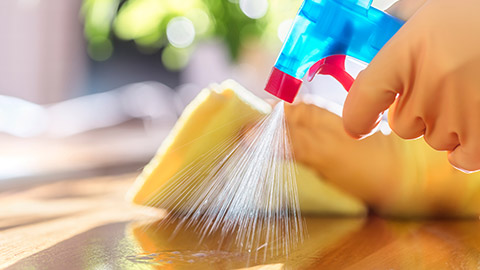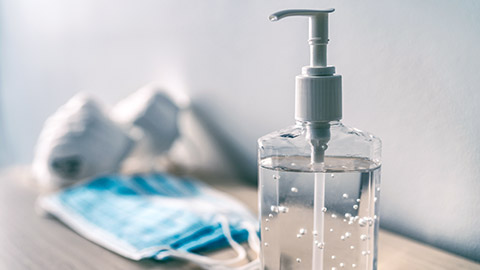Previously, we looked at the systems and processes for ordering stock. We are now going to look at the systems and processes needed for receiving the stock we have ordered.
Stock receiving
Once the stock has arrived at the pharmacy, it is essential to carry out the checking steps. There are nine in total and we have broken them down to three task groups:
- Initial checks
- Unpacking
- Putting new products away.
Initial checks
Before you even unpack the order, you'll want to ensure a few things to keep the process efficient.
- Check boxes: check the boxes are for your pharmacy before the courier leaves (don't sign for anything you haven't checked!!)
- Move: move boxes to designated unpacking space so foot traffic is not obstructed
- Check invoice: check the name on the invoice matches your pharmacy name.
Take a moment and think about what may be involved in each check, and then turn the card to learn more, connecting what you already know to new material.
Unpacking
If the initial checks are all correct, you can proceed to unpack the order as follows:
- Check off items: check off each item on the invoice (ensure the right product, strength, size, quantity, etc. matches the physical stock in the order).
- Check expiry: check for expired items or near expired items. While you're at it check for damaged items. Most of the time short dated items will be brought to your attention by your supplier - there is usually the option to return if you're unsatisfied with short dated items.
- Enter items into stock control system: once all items have been checked off, enter the received items into the stock control system (TONIQ, RXone).
Imagine that you are the one responsible for unpacking the order.
What would you do if:
Putting new products away
You now have all the boxes out of the way, and you know the products delivered are correct and intact. It is time to put the products away in the pharmacy in the appropriate places by following these steps:
- Prepare: prepare items to be put away in appropriate areas of the dispensary, shop or store room
- Put away: PUT AWAY FRIDGE ITEMS FIRST and make note of what you have put away. Remember to rotate all stock (first in - first out principle)
- Check: check, sign and date all associated paperwork.
Special instructions about refrigerated items:
- Cold chain must be maintained by promptly putting received stock into the fridge.
- Space in the fridge can sometimes be limited. It is important not to jam everything in.
- Fridge items are usually more expensive and fragile than other items!
Learn more about the care of cold chain items and controlled drugs with this activity.
Stock holding
Earlier, we provided a definition of stock holding. Can you recall what that term involves? Take a moment and consider what you already know before expanding the label below to connect your existing understanding to any new information.

The practice of maintaining a stock of medicines and products to meet customer needs. The quantity of stock that is held needs to be at a level that avoids the costs of 'out-of-stocks' (not having the product when needed) while at the same time not having too much stock which will incur storage costs.
Quantity of stock held
Let's now consider the factors that can determine the quantity of stock held in a pharmacy at any one time:
- Demand for stock
- High demand items will require greater quantities of stock to be held and frequent ordering
- Examples include: paracetamol, Salbutamol, amoxicillin, ibuprofen.
- Lower demand items will require less quantities of stock to be held and less frequent ordering
- Examples include: Ciclosporin (an immunosuppressant), hydroxyurea (for treatment of cancer).
- High demand items will require greater quantities of stock to be held and frequent ordering
- Space available for storing stock
- Limited in fridge
- Examples include: Novorapid, Latanoprost eye drop, Chlorafast.
- Limited in safe
- Examples include: codeine, methyphenidate, morphine.
- Limited on shelves
- Examples include: Sorbolene, condoms, food supplements.
- Limited in fridge
- Company and supplier discounts
- Discounts offered for larger quantities
- Example: An entire box containing 12 tubs of aqueous cream is sold at a discounted price. Suppose a pharmacy wants to purchase 10 tubs of aqueous cream. In that case, they may buy a box of 12 as the discounted box works out cheaper than buying 10 individual tubs. As aqueous cream is a fast mover, the extra stock will be easily used before expiration.
- Specials or promotions from companies or pharmacies
- Example: the pharmaceutical company Mylan may want to promote a new product and therefore will offer it at a discounted price to pharmacies to encourage them to purchase their product.
- Discounts offered for larger quantities
Self-directed learning activities
Occasionally pharmacies sell stock by the metre/litre or by weight.
Here is a reminder of the basic conversions:
Length
Mass
Volume
| 100cm = 1cm | 1000g = 1kg | 1000ml = 1L |
Journal Post
How much will the customer have to pay?
Using these basic conversions, calculate the following by hand, showing your workings — as will be required for later assessments. When you are ready, take (a) photo(s) of your work, create your journal post, and publish it.
Don't forget to show your working.
- Your first customer requests 120 cm of a dressing. The price of 1m of dressing is $1.90.
How much will the customer have to pay? - The price of methylated spirits is $9.99/L, and a customer would like to know how much 300ml will cost him.
How much will the customer have to pay? - The price of menthol crystals is $3.99/kg. A customer would like to purchase 250g.
How much will the customer have to pay?

Supply orders
Practitioners Supply Order
When dispensing prescriptions, you may come across Practitioners Supply Order (PSO), sometimes called a Medical Practitioner Supply Order (MPSO).
Medical practitioners are:
- doctors
- dentists
- midwives
- nurse prescribers
- optometrists.
A PSO is usually a green A5 form, or it can be a computer-generated form.
The form is used by practitioners to order medicines for:
- emergency administration to patients
- teaching purposes
- to provide to specific patient groups where individual prescribing is not practical.
There is a list of the funded medicines that practitioners can order on a PSO in the PHARMAC Schedule (Section E). The practitioner can order anything they like, but only those items that appear in the schedule and in the quantity specified are funded.
Medicines in Section B of the PHARMAC Schedule that are available on PSO are marked 'available on PSO'. If any conditions must be met, they are written here. An entry may have the condition 'only on a prescription', which means that the drug is only funded when written on a prescription. (i.e. not a PSO).
For pharmaceuticals on a PSO to be funded, they must:
- be written on a form approved by the Ministry of Health
- be personally signed and dated by the prescriber
- include the prescriber's address
- specify the medicines and their quantities.
They must also meet these requirements:
- Class B Controlled Drugs or buprenorphine hydrochloride must be written on a triplicate PSO Controlled Drug Form supplied by the Ministry of Health.
- Section B of the Schedule applicable to the Community Pharmaceutical must be met.
- The Pharmaceutical must be identified in the Schedule as being subsidised on a PSO and only be supplied in such quantities as set out in the Schedule.
Consider this situation:
You receive a PSO for a medicine in a specific quantity. When you check in the PSO list online, you discover the medicine is on the PSO list but not in the quantity that has been prescribed.
Will the medicine still be eligible for the subsidy? (Select your answer below.)
No, that is not correct. Please select No to read why.
Correct! PSO for rural areas are a little different due to their environment. Any community pharmaceutical may be ordered on a rural PSO as long as all the funding requirements of the listing are met and:
- The prescriber's normal practice is in a rural area
- The quantities ordered are reasonable for up to 1 month's supply under the conditions normally existing in the practice.
Bulk Supply order
Although the name sounds like this type of order is for bin food, it's really for supplying a private hospital with a registered nurse to treat the people under the hospital's care.
For pharmaceuticals on a BSO to be funded, they must be:
- written on a form supplied or approved by the Ministry of Health and signed by a Hospital Care Operator
- not exceed a reasonable monthly allocation for the particular institution
- meet all the subsidy requirements of Section B of the Schedule applicable to that Community Pharmaceutical.
- In addition, orders for Class B Controlled Drugs or buprenorphine hydrochloride must be written on a triplicate BSO Controlled Drug Form supplied by the Ministry of Health.
Special authority numbers
Another situation you may encounter while processing prescriptions is special authority numbers.
Research
In your Pharmacy Procedure Manual, go to section Special Authority (pages 53 & 54) for an explanation of what this term means. We recommend keeping this PDF where you can regularly refer to it if you don't already.
When you return here, consider your answers to these questions and expand the labels to learn more.
What does it mean to a patient if an item on their prescription has a special authority number?
It means that the prescription items funding will be increased, so the cost to the patient will be less than it would be without the SA.
Where can you go to find SA information?
- Special Authority Look-up System - online
- National Contact Centre - telephone
Self-directed learning activities
Reflect on your experiences in your work placement when you have been involved in the dispensing process.
Write your own reflective notes in your journal on the following. When you are done, review them and consider reaching out to your peers or tutor in areas you need support.
- How confident do you feel carrying out each step in the dispensing process?
- Are you becoming familiar with prescription medicines and what they are prescribed for?
- What could you do to become more knowledgeable about prescription medicines?
- Do you feel confident using the dispensing software in your pharmacy?
- What have been your challenges when dispensing prescriptions, and how could you overcome these?
- Reflect on the times you have provided patient counselling.
- How confident did you feel?
- Were you able to answer the patient's questions?
- Did you provide all the information required?
- Was your communication clear and respectful?
- Do you have any questions or gaps in your knowledge about the role of a pharmacy technician in the dispensing process?
Ka pai, you've completed Week 12 of Introduction to Dispensing! Take a well-deserved break before continuing.
Physical and chemical methods to reduce pathogen levels

You have already looked at personal and environmental practices to prevent the spread of infection. Other methods to protect ourselves from infection include using physical and chemical means to reduce pathogens in our environment.
Take this quick quiz to brush up on your terminology about pathogens.
On a piece of paper or in a digital note, jot down as many physical and chemical means of pathogen removal or reduction measures that you can think of — you probably know a lot!
Check your answers and add to your knowledge by expanding the labels below.
- Hand washing
Using soap and water to remove pathogens from hands, to help prevent transmission to people and the environment. - Disinfection
Using physical agents such as heat or ultraviolet (UV) radiation to kill or inactivate pathogens on surfaces, objects, or instruments. - Sterilisation
Physical sterilisation includes dry heat, moist heat, pressurised steam, incineration, flame, boiling, and filtration using tiny filter pores to filter out microbes. - Personal protective equipment (PPE)
Wearing PPE, such as gloves, masks, gowns and goggles, serves as a physical barrier between individuals and potential sources of infection. - Isolation and quarantine
Physically separating individuals who are infected or suspected of being infected from healthy individuals can prevent the spread of pathogens.
- Antiseptics
Used to reduce levels of microbes on human tissue reducing the possibility of an infection developing. - Disinfectants
Used on surfaces and the environment to kill bacteria. Not to be used on the skin. - Sterilisation
Use of chemicals such as peracetic acid, to kill all microorganisms on an object. - Preservatives
A natural or synthetic chemical such as benzalkonium is added to pharmaceuticals to prevent decomposition by bacterial growth or unwanted chemical changes.

Consider your own experience and knowledge of pathogens. Can you think of a pathogen that has affected people worldwide since about 2020?
Did you realise that COVID-19 is caused by a pathogen? The specific pathogen responsible for COVID-19 is a novel (not discovered before) coronavirus called severe acute respiratory syndrome coronavirus 2 (SARS-CoV-2).
Human defence system
Some infections are short-lived and easily overcome by the body's natural defence systems. In contrast, others are more serious and require outside intervention in the form of drugs.
The human body has two primary defence systems against pathogens:
- Non-specific defence system, also known as the innate immune system.
- Specific defence system, also known as the adaptive immune system.
Non-specific defence
The non-specific defence system acts immediately when exposed to pathogens.
Watch: 8.11.1 Nonspecific Defense (3:22 minutes)
Within this system, there are two lines of defence. Watch this video to learn what these are, and then answer the following eight questions.
Specific defence
This defence system is the third line of defence against pathogens after the first two types of non-specific defences. This system differs from those in that it targets specific pathogens and is slower to respond when exposed to pathogens.
There are also two types of specific defence:
- cell-mediated immunity: uses specific T cells to destroy the pathogen.
- antibody-mediated immunity: uses B cells and antibodies to react to pathogens.
You will look further at the specific defence system in your SDL activity for this week.
Treating infectious diseases
Serious infections can largely be avoided by measures such as:
- person and environment hygiene practices
- immunisation
- better general health and nutrition for better immunity
- better methods for controlling the spread of disease organisms, including better sanitation, water purification, housing, and pest control.
When an infection does occur, it is important that it is identified early and the appropriate treatment is started.
Treating early means that:
- there is less time for the person to become infectious and spread the illness
- treatment will stop the progression of the illness to avoid serious and life-threatening impacts.
Sometimes it is clear by the symptoms what the infection is, and other times, testing needs to occur to confirm the disease-causing microorganism. Testing may involve taking blood, tissue or body fluid samples that are grown and tested in the laboratory. The results of the testing will guide the appropriate treatment.
A mainstay of treatment is antimicrobial medicines. These need to be carefully selected so effective medicines are prescribed with minimal side effects. Antibiotics treat bacterial infections but must be used with caution to prevent the development of resistant bacteria. Viruses are much harder to treat. Antiviral medications are not very specific, and viruses mutate often, making it hard to treat.
As we continue learning about pathogens, we will discuss more about treatments for specific infections.
Bacteria
You may already know a bit about bacteria already.
Let's start with some bacteria facts.
- Bacteria are single-celled organisms with a cell wall (human cells do not have a cell wall).
- They are found in large quantities in soil, water, and air.
- Most bacteria are harmless to humans.
- Some, in fact, are beneficial, such as those that live in the intestine and help break down food for digestion.
- If the bacteria have a tail-like structure called flagella, it will be able to move.
- The flagella functions like a propeller or a whip, propelling the bacteria forward or allowing them to change direction.
- They move to avoid harmful conditions, approach nutrients or for other reasons to ensure their survival.
- The flagella functions like a propeller or a whip, propelling the bacteria forward or allowing them to change direction.
Pathogenic bacteria are classified, on the basis of shape, into three main groups, as shown in the graphic below:
| Cocci examples | Pneumonia, tonsillitis, bacterial endocarditis, meningitis, toxic shock syndrome and lots of skin disorders. |
| Bacilli examples | Tuberculosis, pertussis, tetanus, typhoid fever, diphtheria, salmonellosis, shigellosis, legionnaires’ disease, and botulism. |
| Spirilla examples | Syphilis, yaws, leptospirosis, and Lyme disease. |
Bacteria can also be classified by their cell wall structure into two types:
- Gram-negative bacteria: Has a thick outer cell wall containing enzymes. Some antibiotics will not be able to penetrate the wall, or they may be broken down by the enzymes in the wall.
- Gram-positive bacteria: does not have the thick outer cell wall that gram-negative has therefore, antibiotics can more easily penetrate the bacteria and destroy it.
Take a moment to consider why it is helpful to know the structure of the bacteria cell wall, and then check the answer by expanding the label below.
Understanding the cell wall structure of bacteria is important in selecting the appropriate antibiotic for the treatment of a bacterial infection. It helps healthcare professionals choose the most suitable antibiotics that can effectively penetrate the cell wall and combat the specific type of bacteria causing the infection.
We will explore treatments for bacterial infections in more detail in the upcoming lessons.
Self-directed learning activities
The body’s defences
Activity 1
Reflect on and list in your journal what physical and chemical methods are used in your pharmacy to reduce pathogen levels.
Activity 2
Watch: 8.11.2 Specific Defense (3:25 minutes)
Watch this video to learn about the specific defence system. Make your own notes from this video to help your learning.
Activity 3
In your journal, describe the difference between an epidemic and a pandemic.
Great work. You have completed Week 12 in Patient Care! It's time to complete your learning Check-in before moving on to Week 13.
